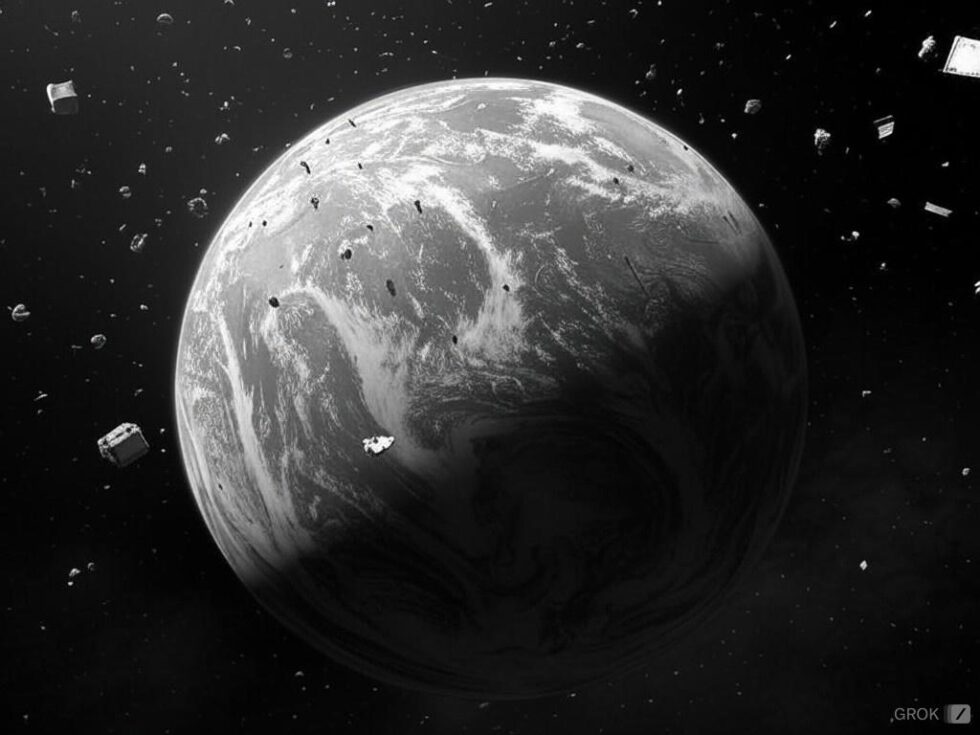
In 2045, the night sky had transformed from a serene tapestry of stars into a chaotic mosaic of shimmering metal and glass. This change was a testament to humanity’s relentless pursuit of progress. The once-clear path around Earth had become a congested highway of space debris, the result of decades of satellite launches, space missions, and orbital neglect. This era, known as the Great Orbital Congestion, was a time when the future of human civilization hung in the balance.
The problem had been brewing for years but reached a critical point when a massive collision occurred between two defunct satellites. The impact was catastrophic, sending thousands of fragments hurtling through space at unimaginable speeds. This event, known as the Cascade, triggered a chain reaction. Each collision created more debris, which in turn caused further collisions. The Kessler Syndrome, once a theoretical scenario, had become a harsh reality.

On Earth, the effects were immediate and profound. Communication networks faltered as satellites were obliterated. GPS systems, once the backbone of navigation, became unreliable. Weather forecasting, reliant on satellite data, was thrown into disarray. The world was plunged into a technological dark age, where the conveniences of modern life were stripped away, leaving humanity to grapple with the consequences of its own hubris.
Governments around the world scrambled to respond. International summits were convened, and scientists worked tirelessly to devise solutions. The United Nations established the Orbital Debris Mitigation Task Force, a coalition of the world’s leading experts in space technology and environmental science. Their mission was clear: to find a way to clear the debris and prevent further collisions.
Amidst the chaos, a young scientist named Dr. Elara Singh emerged as a beacon of hope. With a background in astrophysics and a passion for space exploration, she had dedicated her life to understanding the cosmos. Now, her expertise was needed more than ever. Dr. Singh proposed an ambitious plan to deploy a fleet of autonomous drones equipped with powerful lasers, capable of vaporizing smaller debris and altering the trajectory of larger fragments. It was a bold idea, but one that offered a glimmer of hope in an otherwise bleak situation.

As the world watched with bated breath, the first wave of drones was launched into orbit. The operation, dubbed “Project Clean Sweep,” was fraught with challenges. The drones had to navigate the treacherous debris field, avoiding collisions while targeting their laser beams with pinpoint accuracy. It was a delicate dance, a high-stakes ballet performed in the unforgiving vacuum of space.
Slowly but surely, the drones began to make progress. Bit by bit, the debris field was cleared, and the threat of further collisions diminished. Communication networks were restored, and the world breathed a collective sigh of relief. However, the crisis had left an indelible mark on humanity, a stark reminder of the fragility of life on Earth and the importance of responsible stewardship of the cosmos.
In the aftermath of the Great Orbital Congestion, a new era of cooperation and innovation dawned. Nations that had once been rivals came together to establish the International Space Preservation Treaty, a comprehensive agreement aimed at preventing future debris accumulation. The treaty mandated strict guidelines for satellite launches, requiring all space-faring nations to equip their spacecraft with deorbiting mechanisms and to adhere to sustainable practices.
Dr. Singh’s work did not go unrecognized. She became a global icon, a symbol of resilience and ingenuity in the face of adversity. Her efforts inspired a new generation of scientists and engineers, who were determined to explore the universe responsibly and sustainably. The crisis had been a wake-up call, a catalyst for change that would shape the future of space exploration for generations to come.
As humanity looked to the stars once more, it did so with a newfound sense of humility and wonder. The night sky, no longer marred by the scars of human negligence, became a canvas for dreams and aspirations. The lessons of the past had been learned, and the path forward was clear. In the vast expanse of the cosmos, humanity had found its place, not as conquerors, but as caretakers, united in the pursuit of knowledge and the preservation of the universe’s infinite beauty.




